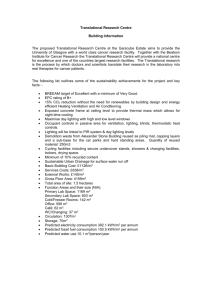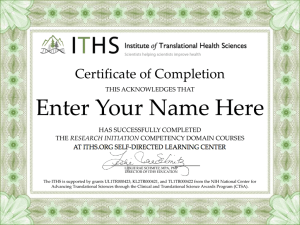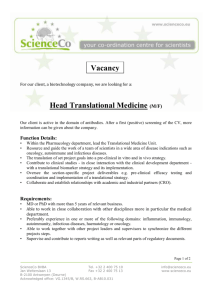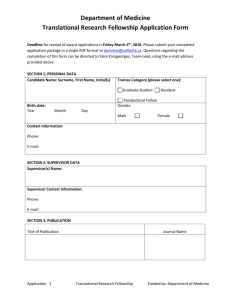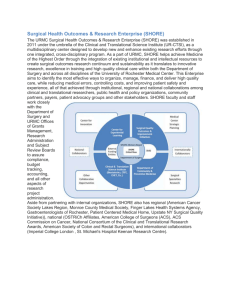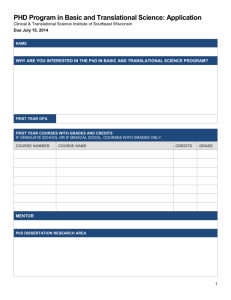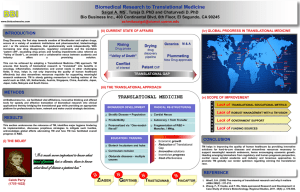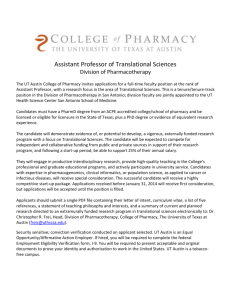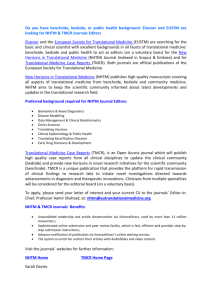Clinical and Translational Science Institute
advertisement
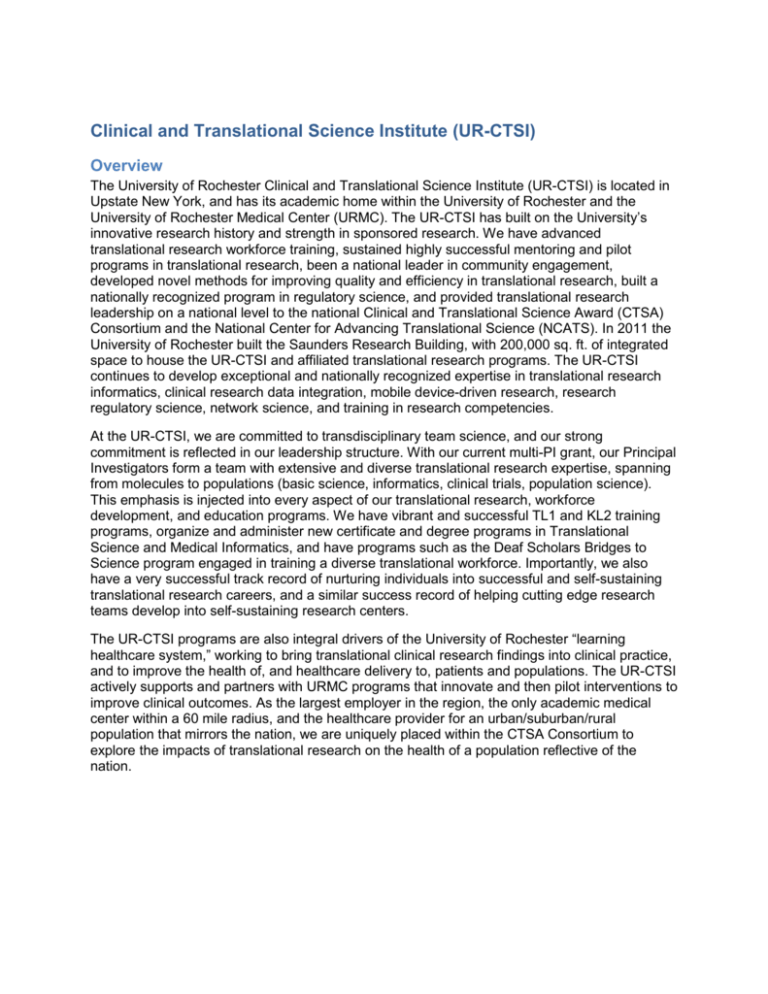
Clinical and Translational Science Institute (UR-CTSI) Overview The University of Rochester Clinical and Translational Science Institute (UR-CTSI) is located in Upstate New York, and has its academic home within the University of Rochester and the University of Rochester Medical Center (URMC). The UR-CTSI has built on the University’s innovative research history and strength in sponsored research. We have advanced translational research workforce training, sustained highly successful mentoring and pilot programs in translational research, been a national leader in community engagement, developed novel methods for improving quality and efficiency in translational research, built a nationally recognized program in regulatory science, and provided translational research leadership on a national level to the national Clinical and Translational Science Award (CTSA) Consortium and the National Center for Advancing Translational Science (NCATS). In 2011 the University of Rochester built the Saunders Research Building, with 200,000 sq. ft. of integrated space to house the UR-CTSI and affiliated translational research programs. The UR-CTSI continues to develop exceptional and nationally recognized expertise in translational research informatics, clinical research data integration, mobile device-driven research, research regulatory science, network science, and training in research competencies. At the UR-CTSI, we are committed to transdisciplinary team science, and our strong commitment is reflected in our leadership structure. With our current multi-PI grant, our Principal Investigators form a team with extensive and diverse translational research expertise, spanning from molecules to populations (basic science, informatics, clinical trials, population science). This emphasis is injected into every aspect of our translational research, workforce development, and education programs. We have vibrant and successful TL1 and KL2 training programs, organize and administer new certificate and degree programs in Translational Science and Medical Informatics, and have programs such as the Deaf Scholars Bridges to Science program engaged in training a diverse translational workforce. Importantly, we also have a very successful track record of nurturing individuals into successful and self-sustaining translational research careers, and a similar success record of helping cutting edge research teams develop into self-sustaining research centers. The UR-CTSI programs are also integral drivers of the University of Rochester “learning healthcare system,” working to bring translational clinical research findings into clinical practice, and to improve the health of, and healthcare delivery to, patients and populations. The UR-CTSI actively supports and partners with URMC programs that innovate and then pilot interventions to improve clinical outcomes. As the largest employer in the region, the only academic medical center within a 60 mile radius, and the healthcare provider for an urban/suburban/rural population that mirrors the nation, we are uniquely placed within the CTSA Consortium to explore the impacts of translational research on the health of a population reflective of the nation. Saunders Research Building The Saunders Research Building (SRB) is not only home to cutting-edge clinical and translational medicine, but the building itself represents an innovation in design. It was designed with an eye toward sustainability and the health of its occupants and represents a new model for creating an academic space that fosters interaction and collaboration among its occupants. Environmentally-friendly design In 2012, the SRB received LEED (Leadership in Energy and Environmental Design) certification at the Gold level, which is the second-highest level out of four. LEED certification evaluates buildings on planning and design, energy savings, water efficiency, CO2 emissions reduction, and indoor environmental air quality. The building energy reduction features also qualify the building to participate in the New York State Energy Research and Development Authority programs for energy conservation, which provide assistance for sustainable building practices. The building’s orientation and shallow footprint maximizes exposure to daylight. Windows wrap around the upper floors and include soffits which extend their height and maximize sunlight exposure. Individual offices are arranged in blocks that run perpendicular to the exterior windows creating an open floor plan which brings more natural light into the interior of the building. The individual offices also have glass walls to allow in ambient light. The lighting system is equipped with sensors that adjust the lighting level depending on the natural light exposure. The lighting controls system in the Saunders Research Building is designed to incorporate best practices regarding the lighting environment for the occupant and for environmental sustainability. The lighting has been pre-programmed to obtain the estimated required light level for a typical work surface (30 footcandles). As part of the building’s sustainability approach, the lighting in windowed spaces will automatically adjust depending on the amount of daylight entering the space. Sound masking (or noise cancelling) has been incorporated into the design of the building to help mitigate noise that can travel through open areas and enclosed offices. Through the careful adjustment by an acoustician the sound masking system is designed to cancel noises that emanate from open area to private office and from private office to open area. The system is set up so that the open office areas are set higher in volume than enclosed offices, as there is generally more noise produced in an open, shared area. Each department will be assigned two zones, one for enclosed offices and one for open office areas. The building’s sustainable design extends to the adjacent grounds where landscaping consists of native and adaptive plants which will reduce the need for irrigation. The parking lot that serves the building will be made of porous pavement which captures and filters storm water and allows it to seep into the ground, recharging groundwater and reducing runoff. A particular effort was made to use “local” materials in the building’s construction. For example, all of the cement in the building’s foundation and floors were made using recycled concrete and aggregate from local sources. 10 percent of the building’s total materials came from within 500 miles of its location. Collaborative space The building also represents a new model of collaborative space. The interior details of the building – glass-walled offices, the height of partitions, shared common and conference rooms, and open staircases – were all designed to promote collaboration and innovation by encouraging the occupants to get out of their office interact with each other. In addition to the UR-CTSI administration, the building also houses The National Center for Deaf Health Research and independent URMC research programs in cardiovascular disease, neurological disorders, cancer, pediatrics, emergency medicine, surgery, the Departments of Public Health Sciences and Biostatistics and Computational Biology, The Office for Human Subject Protection, the Research Subjects Review Board (UR’s IRB), and UR Ventures (UR’s office for technology transfer). Unique Resources available at the SRB: Research Participant/Navigator/Observation Room Room 1.414 is a small room on the first floor’s main corridor which is provided with a one-way window into the adjacent conference room for use in the observation of focus groups and other aspects of qualitative research. It can be reserved for this purpose. The room will also have a curtain over the window and will be used as a resource center for visitors and participants in URMC research studies. It will be furnished with computers and shelves accessing the research studies currently recruiting subjects at URMC. Rooms that promote inclusivity of individuals who are deaf or have hearing loss The SRB is home to the National Center for Deaf Health Research (NCDHR), which is a CDCfunded Community-Based Participatory Research Center that follows the Cultural Model: Deaf people are a minority group who share a common language (ASL) and culture. NCDHR does not follow the Clinical Model which views deafness as a medical condition that should be treated. As a result, the SRB made conscious efforts to accommodate the inclusion of individuals who are deaf or hard of hearing, to promote education of those individuals enrolled in the educational programs, as well as to provide a space to conduct clinical research studies involving the deaf population. The Pearson Room (1.1416) has blue-grey walls designed to reduce eye strain and has chairs arranged in a semi-circle to allow unblocked lines of visual contact during meetings. This is extremely important when meetings are conducted or communicated in sign language. This room also has an Assistive Listening System (ALS) that benefit (s) persons with hearing loss, with or without hearing aids/cochlear implants. CART (Communication Access Realtime Translation) may be used in meetings (CART may also benefit some Deaf people).
